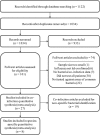The frequency of influenza and bacterial coinfection: a systematic review and meta-analysis
- PMID: 27232677
- PMCID: PMC4947938
- DOI: 10.1111/irv.12398
The frequency of influenza and bacterial coinfection: a systematic review and meta-analysis
Abstract
Aim: Coinfecting bacterial pathogens are a major cause of morbidity and mortality in influenza. However, there remains a paucity of literature on the magnitude of coinfection in influenza patients.
Method: A systematic search of MeSH, Cochrane Library, Web of Science, SCOPUS, EMBASE, and PubMed was performed. Studies of humans in which all individuals had laboratory confirmed influenza, and all individuals were tested for an array of common bacterial species, met inclusion criteria.
Results: Twenty-seven studies including 3215 participants met all inclusion criteria. Common etiologies were defined from a subset of eight articles. There was high heterogeneity in the results (I(2) = 95%), with reported coinfection rates ranging from 2% to 65%. Although only a subset of papers were responsible for observed heterogeneity, subanalyses and meta-regression analysis found no study characteristic that was significantly associated with coinfection. The most common coinfecting species were Streptococcus pneumoniae and Staphylococcus aureus, which accounted for 35% (95% CI, 14%-56%) and 28% (95% CI, 16%-40%) of infections, respectively; a wide range of other pathogens caused the remaining infections. An assessment of bias suggested that lack of small-study publications may have biased the results.
Conclusions: The frequency of coinfection in the published studies included in this review suggests that although providers should consider possible bacterial coinfection in all patients hospitalized with influenza, they should not assume all patients are coinfected and be sure to properly treat underlying viral processes. Further, high heterogeneity suggests additional large-scale studies are needed to better understand the etiology of influenza bacterial coinfection.
Keywords: MRSA; Streptococcus Pneumoniae; antibiotic resistance; bacterial coinfection; influenza; meta-analysis.
© 2016 The Authors. Influenza and Other Respiratory Viruses Published by John Wiley & Sons Ltd.
Figures




References
-
- Thompson WW, Shay DK, Weintraub E et al Mortality associated with influenza and respiratory syncytial virus in the United States. JAMA 2003; 289:179–186. - PubMed
-
- Metersky ML, Masterton RG, Lode H, File TM Jr, Babinchak T. Epidemiology, microbiology, and treatment considerations for bacterial pneumonia complicating influenza. Int J Infect Dis 2012; 16:e321–e331. - PubMed
Publication types
MeSH terms
LinkOut - more resources
Full Text Sources
Other Literature Sources
Medical
Miscellaneous

